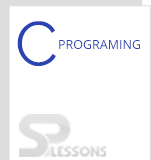 Introduction
Introduction
In C-programming, a variable consists of single data and single data type. An array consists of multiple data and single data type. Continuing in advance, Structure in C consists of multiple data and multiple data types, sometimes called records in other languages.
Structure in C can be defined as group of variables with same name and different data types which can be created, pointed to, copied, and refer to conveniently and easily. Unlike in C++, the names of structures are declared in a separate name space in C. .
 Description
Description
Defining a structure can be done two ways.
- Using "struct" as the datatype
- Using header file
 Syntax
Syntax
struct structure_name
{
//statements;
};
 Example
Example
[c]
#include<stdio.h>
#include<conio.h>
struct student
{
char name[20];
int age;
float percentage;
}file;
int main()
{
strcpy(file.name, "John");
file.age=25;
file.percentage=78-9;
printf("Name is %s\n",file.name);
printf("age is %d\n",file.age);
printf("percentage is %f\n", file.percentage);
}[/c]
Output:
[c]
Name is John
age is 25
percentage is 69.000000
[/c]
 More Info
More Info
Every member of structure is called as
Structure Member or an Element.In the above example, John, age,percentage are called as tags which are of different data types.
 Description
Description
The structures can be accessed using the dot . operator. Structure can also be accessed by using ->. As using arrow is bit complex, dot operator is used.
 Description
Description
Any structure is initialized in order to access it and allocate a memory to it.
Declaring will be same as defining.Coming to defining a structure, assign values to variables at the end of structure block( after the braces) by giving a semicolon.
 Example
Example
[c]
struct student
{
char name[20];
int age;
float percentage;
}
student1={"John",15,77.5};
student2{"Mike",16,78};[/c]
 More Info
More Info
When there are no values to declare, structure should be declared as null.Otherwise, there will be no memory allocation for the variable.
 Description
Description
There is also another way for defining a structure by using "header files".
- Create the file with .h extension and write the structure code as follows.Now write the structure code in it and save.
- Open other file with extension .c and include the header section created before and use it in the program. Eg: #include "structure.h".
 Example
Example
[c]
#include<stdio.h>
#include<conio.h>
#include"structure.h"
int main()
{
strcpy(file.name, "splessons");
file.age=25;
file.percentage=78-9;
printf("Name is %s\n",file.name);
printf("age is %d\n",file.age);
printf("percentage is %f\n", file.percentage);
}[/c]
Note:
Just declaring the structure will never allocate memory to it.Structure must be initialized. Description
Description
An Array is the collection of similar type of elements stored in continuous memory address whose range is defined before the declaration.The elements in array can be selectively updated.
 Example
Example
[c]
#include <stdio.h>
#include <string.h>
struct student
{
int id;
char name[30];
float percentage;
};
int main()
{
int i;
struct student record[2];
// 1st student's record
record[0].id=1;
strcpy(record[0].name, "John");
record[0].percentage = 86.5;
// 2nd student's record
record[1].id=2;
strcpy(record[1].name, "Mike");
record[1].percentage = 90.5;
// 3rd student's record
record[2].id=3;
strcpy(record[2].name, "Anderson");
record[2].percentage = 81.5;
for(i=0; i<3; i++)
{
printf("Records of STUDENT : %d \n", i+1);
printf("Id is: %d \n", record[i].id);
printf("Name is: %s \n", record[i].name);
printf("Percentage is: %f\n\n",record[i].percentage);
}
return 0;
}[/c]
Output:
[c]
Records of STUDENT : 1
Id is: 1
Name is: John
Percentage is: 86.500000
Records of STUDENT : 2
Id is: 2
Name is: Mike
Percentage is: 90.500000
Records of STUDENT : 3
Id is: 3
Name is: Anderson
Percentage is: 81.500000
[/c]
 Description
Description
The information is passed to the functions by using arguments.Basically, a function consists of fixed number of parameters and for every parameter passing of an argument is needed.
The memory address given to a particular variable is called as a Pointer.
 Example
Example
[c]
#include <stdio.h>
#include <string.h>
struct student
{
int id;
char name[30];
float percentage;
};
int main()
{
int i;
struct student record1 = {1, "William", 90.5};
struct student *ptr;
ptr = &record1;
printf("Records of STUDENT1: \n");
printf(" Id is: %d \n", ptr->id);
printf(" Name is: %s \n", ptr->name);
printf(" Percentage is: %f \n\n", ptr->percentage);
return 0;
}[/c]
Output:
[c]
Records of STUDENT1:
Id is: 1
Name is: William
Percentage is: 90.500000
[/c]
 Key Points
Key Points
- Variables of different data type and same name in structures can be accessed with dot operator.
- Every structure member are given different memory space and can be accessed individually.
 Programming
Tips
Programming
Tips
- The structure declaration type must end with a semicolon( ; ).
- Basically, structure in C is written in global declaration section.That can also be done in main section.
- Initialization of all the members of the structure is not necessary.



